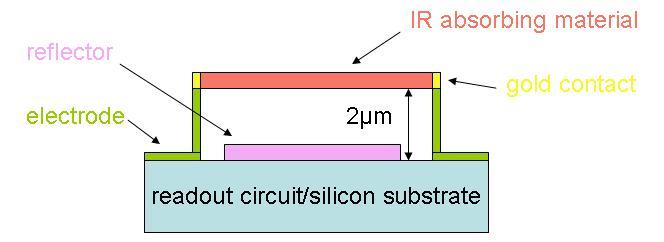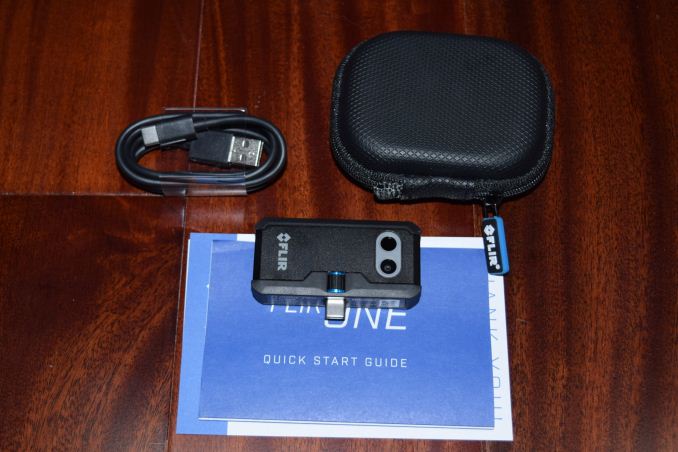FLIR ONE Pro Thermal Camera Review
by Ganesh T S on June 6, 2017 8:45 AM EST- Posted in
- Gadgets
- Thermal Imaging
- FLIR
- USB-C

We had written about the launch of the third-generation FLIR ONE along with the FLIR ONE Pro (and other professional thermal imagers) as part of our 2017 CES coverage. Today, FLIR is officially putting up the 3rd Gen. FLIR ONE and the FLIR ONE Pro for sale. Both are devices that plug into a mobile device (Android or iOS), turning them into versatile thermal cameras. While the FLIR ONE caters to DIY folks and home owners, the FLIR ONE Pro serves the market segment that requires advanced features (including contractors, home inspectors, plumbers etc.) As part of the press, we were provided a preview sample of the Android version of the FLIR ONE Pro.
Introduction
The costs associated with thermal imaging systems have restricted their usage and kept it out of reach of the average consumer / impulse-buy territory. However, advancements in this field over the last few years have made the prices of such system more palatable to non-professional users. These have also contributed to the integration of thermal imaging features in extremely compact systems (including integration into smartphones such as the CAT S60). Thanks to the advent of smart mobile devices, the costs associated with the storage, control and user-interface for these systems could be taken out for most markets.
FLIR made one of the first forays into this space with the first-generation iOS-only FLIR ONE. Seek Thermal entered the fray to cater to Android users, before FLIR themselves released an Android version of the FLIR ONE. Since then, we have had both FLIR and Seek Thermal announce a host of new products with higher resolution sensors. Before going into the technical details of the latest set of products, some readers might appreciate a recap of the basics of thermal imaging that we covered in our review of the Seek Thermal camera.
Thermal Imaging Basics
All materials emit infrared energy and the intensity is a function of its temperature. In simple terms, the higher the temperature, the greater the intensity. Thermal imaging systems utilize a sensor to convert the emitted infrared energy into electrical impulses for further processing. In general, these sensors are called bolometers - they are made of materials whose electrical resistance is dependent on the temperature. The heating is triggered by the power of the incident electromagnetic radiation. Note that bolometers can be used for any type of electromagnetic radiation, though they are typically best suited for infrared and microwave frequencies. A microbolometer is a particular type of bolometer suitable for infrared wavelengths, making them suitable for use in thermal imaging systems. The microbolometer used in the FLIR ONE Pro is the FLIR Lepton 3, and it responds to long-wave infrared radiation (wavelenghts between 8 and 14 microns).
A microbolometer consists of an array of pixels. The Lepton 3 (PDF) has a 160 x 120 array (for around 19.2K thermal pixels). Each pixel has multiple layers, as shown in the cross-sectional diagram below.
"Cross-sectional microbolomter". Licensed under Public Domain via Wikipedia
Depending on the manufacturer, the manufacturing procedure and absorbing materials can differ. Amorphous silicon and vanadium oxide (VO) are the two commonly used infrared radiation detecting materials. Despite being lower in performance and longevity compared to amorphous Si, VO is preferred as it has been around for quite some time (more mature) compared to a-Si. The Lepton 3 sensor also uses VO as the IR radiation detecting material. The pixel array in the microbolometer is usually encapsulated in a vacuum to increase the life of the device. The construction of the microbolometer also determines the supported temperature range. The FLIR ONE Pro / Lepton 3 combination can detect temperatures between -20 C and +400 C.
As one of the graphs in the a-Si link above shows, we have also seen a decrease in the dimensions of the individual pixels. While older devices had a pixel pitch of 45 um, newer devices such as the Lepton 3 have a pixel pitch of just 12 um. With decreasing pixel size, the number of pixels per unit area increases to provide higher resolution images.
Unlike regular cameras (which use regular glass or plastic lenses), thermal cameras can't use materials that reflect thermal radiation. The commonly used materials for thermal lenses are germanium, zinc selenide, zinc sulphide, silicon, and chalcogenide glass. The FLIR ONE Pro uses a silicon doublet lens.
The FLIR ONE Pro
The FLIR ONE Pro comes with a compact carrying case that can also hold the USB-C charging cable. The unit can operate up to 1 hour on a single charge (though that duration drops down drastically if one takes videos). Charging the unit from 0 to 100% takes around three-quarters of a hour. The design is rugged. FLIR claims that the unit has been drop-tested up to 1.8m.
The rectangular unit has dimensions of 68mm x 34mm x 14mm, and weights approximately 37 grams. In addition to the 160x120 Lepton 3 sensor inside the unit, the FLIR ONE Pro also includes a 1440x1080 visible image sensor. The field of view is 55 degrees (horizontal) and 43 degrees (vertical). As with all consumer thermal imaging cameras, the video frame rate is capped at 9 Hz.
The OneFit connector is controlled by the wheel just below the USB-C male connector. Adjusting it (clockwise / anti-clockwise rotation) allows the USB-C connector to extend out by up to 4mm. This allows protective phone cases to be used while operating the FLIR ONE Pro. The USB-C connection obviously solves the orientation issue that plagued the previous generation FLIR ONE for Android when used with certain mobile phones.
The Android apps (FLIR One and FLIR Tools) control / bring out many of the operational features (such as MSX, spot temperature meters, post processing of generated radiometric JPEGs etc.). The next section covers the two Android apps in detail.


















40 Comments
View All Comments
Nottheface - Tuesday, June 6, 2017 - link
From http://www.flir.com/flirone/store/?id=81769:"Expanded Measurement
FLIR ONE Pro’s expanded temperature range means you can measure temperatures between -4°F and 752°F (-20° to 400°C). With up to three spot temperature meters and six temperature regions of interest, FLIR ONE Pro gives you added on-the-go image analysis and reporting capability."
So why do you say in the article that is can only track up to 150ºC?
ganeshts - Tuesday, June 6, 2017 - link
I mention the rated specs in the piece. The 150C is what we tested. Doesn't mean the Pro can't 'see' above thatMorawka - Tuesday, June 6, 2017 - link
Check out Seek's RevealPro. It's $600 but it has 320x240 with the visible spectrum camera and overlays. Plus it does fast motion capture. They make a cheaper unit for around $400 which features a 206x156 sensor with a dedicated lcd screen and flashlight. Seek's gonna eat FLIR's lunch when it comes to consumer/prosumer IR camerasR7 - Friday, June 9, 2017 - link
Yeah. Im sure FLIR is shaking in their boots about competitors much more expensive device that despite having higher res sensor produces noticeably worse images due to the lack of MSX like technology.fobosca - Tuesday, June 6, 2017 - link
This is just toy for the kids. I am not sure why they using word *PRO*. Maybe you can use it for home inspection if your customer is not too picky. Useless for anything else. Oh of cuz you can check your steak temperature...Beany2013 - Thursday, June 8, 2017 - link
My brother is a mechanical engineer (he does installation, troubleshooting, etc of industrial plant gear) and uses the basic one just to get a feel for where heat is building up, and using that to help diagnose things like gearboxes lacking lubrication, wires carrying too much current, components that are overstressed etc - without ripping the equipment apart, risking electric shock or physical injury, etc.You don't necessarily need to know the specific temperature at that point - just that something is hotter than it should be, or hotter than the surrounding area or it's complimentary components.
Wheel bearings or brake disks on the car are a more prosaic example; think you have a binding caliper? Drive the car for a couple of miles, pull over, check each disk with the 'cheapy' FLIR camera and you'll have a pretty good idea of whether it's a binding caliper or a wheel bearing, from where the heat is. He did that to diagnose a knackered driveshaft, rather than a knackered wheelbearing, without having to get the car up on stands and shake everything about.
So they do have uses beyond novelty, even at this 'basic' level.
RandomUsername3245 - Tuesday, June 6, 2017 - link
Watch out linking to Sofradir's opinion on a-Si vs. VOx. This is (almost) like linking to an AMD review published on Intel's website :)Almost every microbolometer vendor I know of uses one technology or the other (a-Si, VOx). They claim their choice is technically superior and all others are slightly worse.
KidneyBean - Wednesday, June 7, 2017 - link
Disappointed that the sample photos don't show tests on the seal around the refrigerator with the door closed, or around house entrance doors or windows. Or maybe a water heater to see if it's insulating jacket could use improvement somewhere. Or if it could be used to spot a water leak.scmorange16 - Wednesday, June 7, 2017 - link
Can this be used to detect Paranormal activity?JanW1 - Wednesday, June 7, 2017 - link
Like natural gas burners magically staying at a cool 150°C?